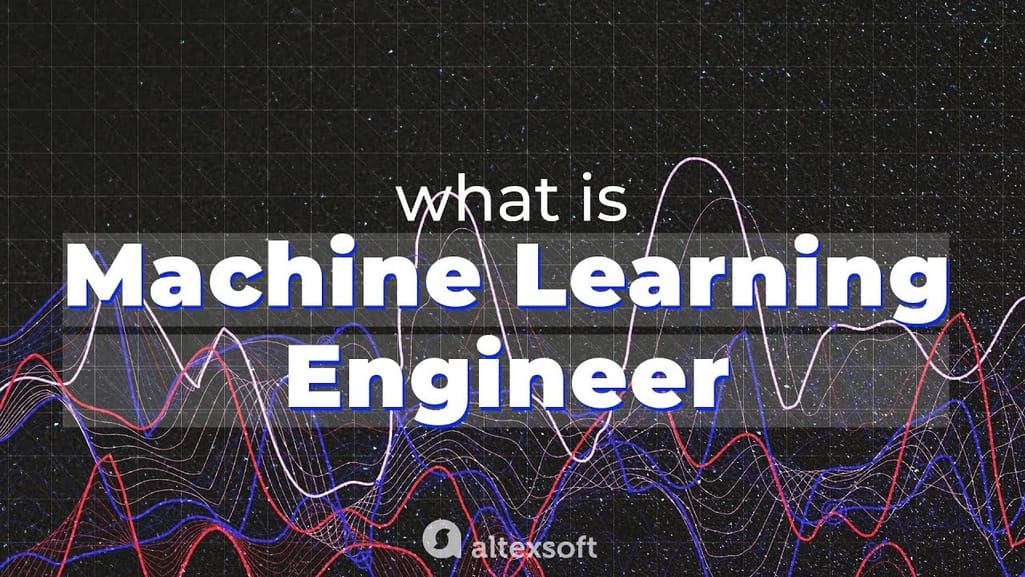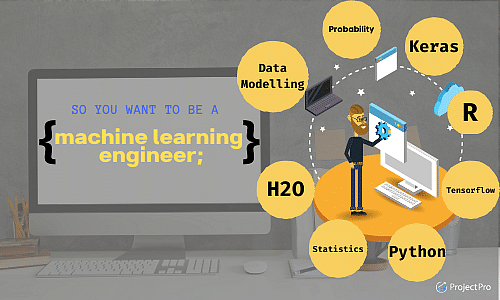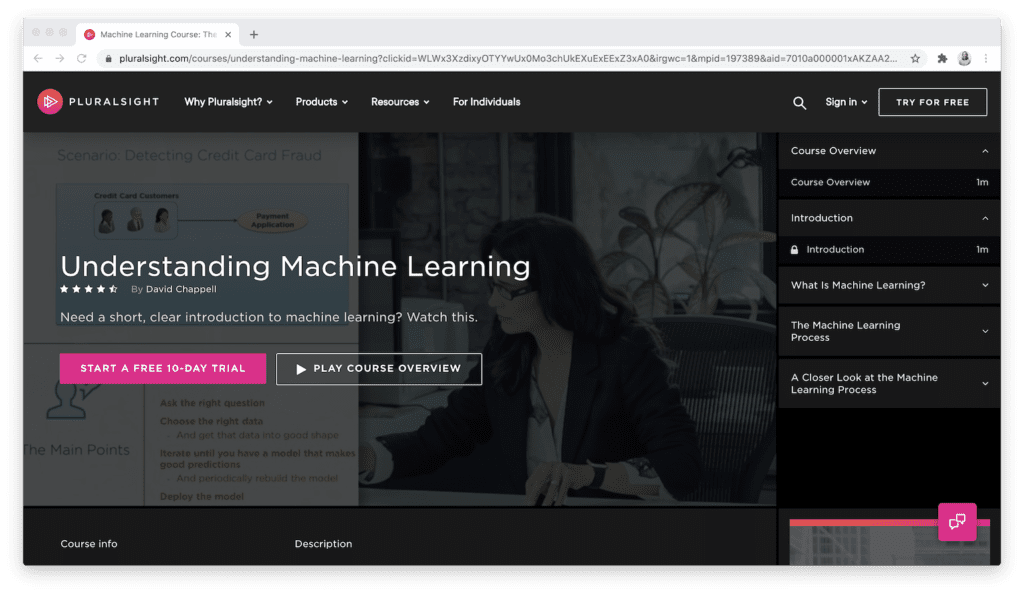All Categories
Featured
Table of Contents
- – Excitement About Machine Learning Devops Engineer
- – Getting My Software Engineering For Ai-enabled...
- – Certificate In Machine Learning Can Be Fun Fo...
- – 9 Simple Techniques For New Course: Genai For...
- – What Does Machine Learning In A Nutshell For...
- – The Facts About Should I Learn Data Science ...
You possibly know Santiago from his Twitter. On Twitter, daily, he shares a great deal of sensible features of artificial intelligence. Thanks, Santiago, for joining us today. Welcome. (2:39) Santiago: Thanks for welcoming me. (3:16) Alexey: Prior to we go into our main subject of moving from software program engineering to artificial intelligence, perhaps we can start with your background.
I went to college, got a computer system scientific research level, and I started developing software. Back then, I had no concept concerning maker discovering.
I know you have actually been using the term "transitioning from software program design to machine learning". I such as the term "including in my skill set the equipment understanding skills" extra due to the fact that I assume if you're a software program designer, you are already providing a lot of value. By integrating artificial intelligence currently, you're augmenting the influence that you can have on the sector.
That's what I would certainly do. Alexey: This returns to among your tweets or perhaps it was from your course when you contrast two methods to understanding. One approach is the problem based method, which you simply talked around. You find an issue. In this situation, it was some problem from Kaggle about this Titanic dataset, and you just learn how to resolve this problem making use of a specific device, like choice trees from SciKit Learn.
Excitement About Machine Learning Devops Engineer
You initially discover mathematics, or direct algebra, calculus. Then when you recognize the math, you most likely to equipment understanding theory and you discover the concept. After that four years later, you ultimately come to applications, "Okay, how do I use all these 4 years of math to resolve this Titanic trouble?" ? In the previous, you kind of save on your own some time, I believe.
If I have an electric outlet below that I need changing, I do not intend to go to college, spend four years understanding the math behind electrical power and the physics and all of that, just to transform an electrical outlet. I prefer to begin with the outlet and find a YouTube video clip that assists me experience the issue.
Santiago: I actually like the concept of starting with an issue, trying to toss out what I know up to that problem and understand why it does not work. Grab the tools that I need to fix that problem and begin excavating much deeper and much deeper and deeper from that factor on.
That's what I typically recommend. Alexey: Possibly we can chat a little bit about learning resources. You mentioned in Kaggle there is an intro tutorial, where you can obtain and discover just how to make choice trees. At the beginning, before we started this interview, you mentioned a couple of publications as well.
The only requirement for that program is that you recognize a little of Python. If you're a programmer, that's a wonderful base. (38:48) Santiago: If you're not a developer, after that I do have a pin on my Twitter account. If you go to my profile, the tweet that's going to be on the top, the one that says "pinned tweet".
Getting My Software Engineering For Ai-enabled Systems (Se4ai) To Work

Also if you're not a designer, you can start with Python and work your means to even more artificial intelligence. This roadmap is focused on Coursera, which is a system that I actually, actually like. You can audit every one of the programs free of cost or you can spend for the Coursera registration to get certifications if you want to.
So that's what I would certainly do. Alexey: This comes back to one of your tweets or possibly it was from your training course when you contrast two methods to learning. One approach is the trouble based technique, which you simply chatted around. You locate an issue. In this case, it was some trouble from Kaggle about this Titanic dataset, and you just find out just how to fix this issue making use of a particular device, like choice trees from SciKit Learn.

You initially find out mathematics, or straight algebra, calculus. When you understand the math, you go to machine knowing concept and you find out the concept.
If I have an electric outlet below that I need changing, I don't wish to most likely to college, spend four years understanding the math behind electrical energy and the physics and all of that, just to change an electrical outlet. I prefer to start with the outlet and discover a YouTube video that assists me undergo the trouble.
Santiago: I truly like the idea of starting with a problem, attempting to toss out what I know up to that issue and recognize why it doesn't function. Order the tools that I need to resolve that problem and begin excavating deeper and much deeper and much deeper from that factor on.
So that's what I normally advise. Alexey: Possibly we can speak a little bit regarding discovering resources. You stated in Kaggle there is an introduction tutorial, where you can get and discover how to make decision trees. At the start, prior to we started this interview, you stated a pair of books as well.
Certificate In Machine Learning Can Be Fun For Anyone
The only requirement for that training course is that you understand a little bit of Python. If you go to my account, the tweet that's going to be on the top, the one that claims "pinned tweet".
Even if you're not a designer, you can start with Python and function your way to even more device knowing. This roadmap is concentrated on Coursera, which is a platform that I really, really like. You can examine all of the programs absolutely free or you can spend for the Coursera membership to get certifications if you wish to.
9 Simple Techniques For New Course: Genai For Software Developers
That's what I would do. Alexey: This returns to one of your tweets or maybe it was from your training course when you contrast 2 approaches to understanding. One technique is the problem based technique, which you simply discussed. You discover a problem. In this instance, it was some problem from Kaggle about this Titanic dataset, and you simply learn just how to address this trouble utilizing a details tool, like choice trees from SciKit Learn.

You initially discover mathematics, or linear algebra, calculus. When you recognize the mathematics, you go to maker knowing concept and you find out the theory.
If I have an electrical outlet below that I need changing, I do not desire to most likely to college, spend four years understanding the mathematics behind electricity and the physics and all of that, simply to transform an outlet. I prefer to begin with the outlet and discover a YouTube video clip that helps me experience the problem.
Santiago: I actually like the concept of beginning with an issue, trying to toss out what I know up to that trouble and recognize why it doesn't work. Grab the tools that I need to fix that trouble and start excavating much deeper and much deeper and deeper from that factor on.
Alexey: Maybe we can speak a little bit regarding finding out resources. You pointed out in Kaggle there is an introduction tutorial, where you can get and discover how to make decision trees.
What Does Machine Learning In A Nutshell For Software Engineers Mean?
The only demand for that training course is that you know a little bit of Python. If you go to my profile, the tweet that's going to be on the top, the one that states "pinned tweet".
Also if you're not a developer, you can begin with Python and work your method to even more artificial intelligence. This roadmap is concentrated on Coursera, which is a system that I really, really like. You can audit all of the programs totally free or you can pay for the Coursera membership to get certificates if you intend to.
That's what I would certainly do. Alexey: This returns to among your tweets or maybe it was from your training course when you contrast 2 strategies to knowing. One method is the problem based technique, which you just discussed. You discover a trouble. In this case, it was some problem from Kaggle about this Titanic dataset, and you simply find out how to resolve this issue utilizing a particular device, like choice trees from SciKit Learn.
You first find out math, or direct algebra, calculus. When you know the math, you go to device discovering concept and you discover the theory.
The Facts About Should I Learn Data Science As A Software Engineer? Revealed
If I have an electric outlet right here that I need changing, I don't wish to go to university, spend 4 years comprehending the mathematics behind electrical energy and the physics and all of that, just to transform an outlet. I prefer to begin with the outlet and discover a YouTube video clip that helps me go with the trouble.
Bad example. You get the idea? (27:22) Santiago: I really like the idea of beginning with a problem, trying to throw away what I recognize approximately that trouble and understand why it does not function. Order the tools that I require to fix that problem and start excavating deeper and deeper and deeper from that factor on.

Alexey: Perhaps we can talk a little bit regarding learning resources. You stated in Kaggle there is an intro tutorial, where you can obtain and discover exactly how to make decision trees.
The only demand for that training course is that you understand a little bit of Python. If you go to my profile, the tweet that's going to be on the top, the one that says "pinned tweet".
Even if you're not a developer, you can begin with Python and work your means to even more artificial intelligence. This roadmap is concentrated on Coursera, which is a system that I actually, truly like. You can audit all of the training courses for cost-free or you can spend for the Coursera subscription to get certifications if you wish to.
Table of Contents
- – Excitement About Machine Learning Devops Engineer
- – Getting My Software Engineering For Ai-enabled...
- – Certificate In Machine Learning Can Be Fun Fo...
- – 9 Simple Techniques For New Course: Genai For...
- – What Does Machine Learning In A Nutshell For...
- – The Facts About Should I Learn Data Science ...
Latest Posts
The Best Online Platforms For Faang Software Engineer Interview Preparation
Software Engineer Interviews: Everything You Need To Know To Succeed
How To Pass System Design Interviews At Faang Companies
More
Latest Posts
The Best Online Platforms For Faang Software Engineer Interview Preparation
Software Engineer Interviews: Everything You Need To Know To Succeed
How To Pass System Design Interviews At Faang Companies